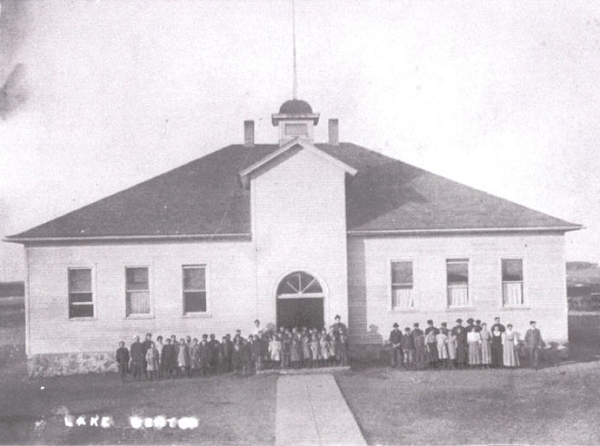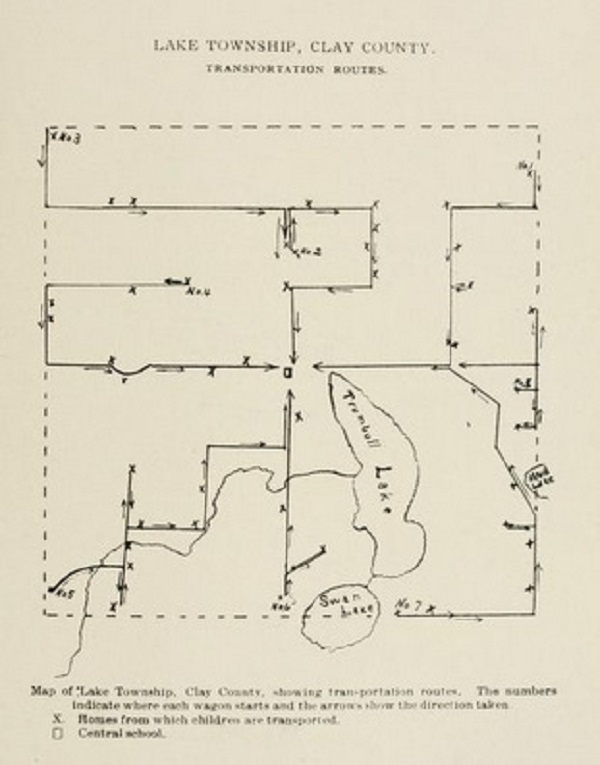Lake Center Consolidated School
Moss Mason, a resident of Lake Township and a member of the local school board, felt strongly about forming one central grade school. The issue came to a vote and passed easily. The wooden, four-room school opened in the fall of 1903 with grades one through nine. The structure cost $3,200 to build. All the township one room school houses were closed. In the 1920's grades 10, 11 and 12 were added. In 1913 Lake Center had a 10th grade graduation. This school was demolished in 2017.

Lake Center School 1910
Submitted by Arlene Zielstra McMillin.
From HISTORY OF CLAY COUNTY, IOWA
FROM ITS EARLIEST SETTLEMENT TO l909
BY Samuel Gillespie and James E. Steele
On January 10, 1905, in company with County Superintendent H. F. Fillmore, I visited the Lake township central school. The day was very cold, mercury registering ten degrees below zero. Our visit was unannounced and unexpected. We found ninety-eight pupils present out of a total enrollment of one hundred and nineteen.
The school is located at the geographical center of the township, and the nearest building of any description is three-fourths of a mile distant. The schoolhouse, erected at a cost of three thousand two hundred dollars, is the only building in the township of a public character, there being no church, hall, shop, or store of any description. This school is in its second year. The children are conveyed to and from their homes in hacks. Three of these are provided with stoves and the others have blankets and robes. All are completely covered. The average cost per team for transporting pupils is twenty-eight dollars per month. Two young men attending school are among the drivers.
As one of the direct results of consolidation in Lake township may be mentioned the fact that this winter four miles of excellent gravel road have been made ‐ the first attempt in that part of Clay county at this class of improvement. The work was mostly done by farmers gratuitously. They expect to continue the work next winter, and it will be but a few years until this township will have excellent roads, and the value of every acre of land in the township will be enhanced thereby. Last year the roads were so bad that transportation was next to impossible for a considerable time, but the people of Lake township have staying qualities, and they are proving the practicability of consolidation in the one township of all others in Clay county most unfavorable for the undertaking. Church and Sunday school are held there in the school building on Sundays and the hacks used to carry the children during the week are used to some extent to carry the people to church on Sunday.
The eight drivers furnish their own teams and hacks, and are under written contract.
The different routes are indicated on the map appearing in this report.
The first child called for on Route No. 1 must ride 6 miles.
The first child called for on Route No. 2 must ride 4 1/2 miles.
The first child called for on Route No. 3 must ride 6 miles.
The first child called for on Route No. 4 must ride 6 miles.
The first child called for on Route No. 5 must ride 7 miles.
The first child called for on Route No. 6 must ride 4 1/4 miles.
The first child called for on Route No. 7 must ride 9 miles.
The first child called for on Route No. 8 must ride 6 miles.

Map of the Bus Routes
The driver for Route No. 2 receives 20.00 per month.
The driver for Route No. 3 receives 28.00 per month.
The driver for Route No. 4 receives 30.00 per month.
The driver for Route No. 5 receives 31.00 per month.
The driver for Route No. 6 receives 20.00 per month.
The driver for Route No. 7 receives 30.00 per month.
The driver for Route No. 8 receives 25.00 per month.
For the purpose of comparison, I give the following table showing enrollment, attendance, etc., in Lake township for the years indicated, the first four under the old district plan and the last under the consolidated plan:
| Year | Enrolled | Average Daily Attendance | Total Paid Teachers | Paid for Fuel, Repairs, and Janitor. | Month's of School | Average Compensation Teachers Males | Average Compensation Teachers Females |
| 1900 | 126 | 62 | $1,479.00 | $150.00 | 8 | $27.12 | $27.45 |
| 1901 | 120 | 55 | 1,639.00 | 120.00 | 8 | 29.23 | |
| 1902 | 107 | 64 | 1,650.00 | 150.00 | 8 | 28.92 | |
| 1903 | 96 | 70 | 1,102.10 | 380.00 | 5.5 | 28.00 | 29.60 |
| 1904 | 116 | 101 | 803.25 | 150.00 | 8 | 50.00 | 37.50 |
It will be seen from the above table that the average daily attendance was sixty per cent, greater in 1904 than the average in the township for the four preceding years.
In 1905 the principal received $50 per month and the grade teachers $40 each per month.
The cost per month of maintaining the Lake township central school at present is:
Teachers' salaries $130.00
Transportation (eight teams) 224.00
Fuel and janitor service (estimated) 20.00
Total $384.00
The assessed valuation of the township is $178,000. On the present basis of cost the levy for teachers' and contingent funds combined for eight months of school would be but 17.2 mills.
For the year 1902, when eight months of school was maintained in the seven separate districts, the levy was 10 mills (assuming that the assessed valuation was the same as now). But for the year 1902 the average daily attendance in the township was but sixty-four, whereas it is now over one hundred. The people are spending more in dollars and cents, but they are getting more for the money spent.
Pupils are transported this winter from forty-one homes. To each of these homes I sent a letter requesting answers to the following questions:
1. Do you regard the school now being conducted in Lake township as being better than the school you had previous to consolidation ?
2. When the schools of this township were consolidated did you favor consolidation or oppose it?
3. Are you now in favor or opposed to consolidation in this township?
4. Give reasons to your answers to question 3.
5. What advantages, if any, have resulted from consolidating the schools of this township?
6. What disadvantages, if any, have resulted from consolidating the schools of this township?
Thirty-two answers were received. Of these twenty-six patrons say the school is better than formerly, most of them say much better.
Fourteen of the thirty-two were opposed at first, and ten are still opposed.
THE BENEFITS CLAIMED.
Those favoring the central school were very positive in their opinions. Mr. J. P. Livingston, a director in the township for eight years, answers the six questions submitted as follows:
1. Yes, far ahead of it.
2. Yes and no, because the roads were not fit.
3. In favor.
4. Better school. Better teachers. Better roads. Children like to go better and advance more in one year than in two the old way. Children go ahead instead of standing still as they ofttimes did the old way. Also better attendance.
5. The roads have become better. Property is worth more and a better feeling all around.
6. It has cost more so far. I don't know of any other disadvantage. Hope the good work may go on.
The following are the principal arguments offered by others in defense of the new way as opposed to the old:
Children attend more regularly.
The pupils are learning better in every respect.
Better attendance.
Bad weather doesn't interfere with attendance.
Inexperienced teachers are eliminated.
Better classification.
Pupils learn more in the same length of time, six months in the consolidated school being worth more than nine months in the district school, which means less relative expense.
Pupils have a graded school.
No pupil ever tardy.
Larger classes.
Country children get equal advantages with city children.
Parents know where their children are during the day.
More rivalry for excellence.
No exposure of children to inclement weather.
Better teachers.
Only slight advance in cost, cheaper per pupil considering work done.
Gives teachers time for individual work.
Fits children to enter high schools.
One schoolhouse only to keep up.
Better teachers and fewer of them to pay.
More interest in school work.
Causes improvement of roads.
Children can be educated without being sent to city.
Many go that would not go to district schools, among larger children.
THE OBJECTlONS URGED.
Those who still oppose the plan of having but one school in the township urge the following objections:
"It makes all the school in winter and none in summer and it does not give the small children any advantage. I am also opposed to boys driving the bus. (Two of the young men students drive hacks in this township). It also makes too long a day, starting at 7 o'clock and not coming home until 6 p. m. The disadvantage of the consolidation are poor roads, and also raising the school tax almost double."
"It is too hard on children from six to ten years of age. Some must start before daylight and do not get home until after dark, and ride ten miles. It makes most of the school in cold weather. About the only advantage is getting a better grade of teachers and it doesn't take as many. It costs too much money for transportation."
"The school is better, but in wet time the scholars can not be transported on account of the bad roads, there is no place for the drivers to stay during the day, the cost is double the district plan and the house is located in a frog pond. But the scholars never are tardy, they have the benefit of a graded school, and are transported in a warm bus."
"If a good teacher were hired the district school is the best. The graded school is an advantage, but the district is better, figuring expense, and the long ride of pupils. The disadvantage is the great expense."
"I think it is a damage to the township. There are no advantages over the old way. It costs us more."
"It is too far away for little children in cold weather. Don't like some of the men they have for drivers."
"To expensive and too far away from patrons on the out-edge of the township."
"The children are obliged to start about 7 o'clock and do not get home until 5:50. They can not have time to help at home at all when they are going to school."
"It makes taxes one-half higher. I opposed it for the reason that I am not located right. My children leave home at 7:15 to 7:30 a. m. and do not get back until 5:40 to 6 p.m."
To show the comparative cost of maintaining the old plan schools with the consolidated plan, the following figures, levies made for school purposes for Lake township, for the years indicated, are here given :
For 1902 — Teachers' fund, 7 mills; contingent fund, 7 mills; schoolhouse fund, 6 mills.
For 1903 — Teachers' fund, 6 mills; contingent fund, 11 mills; schoolhouse fund, 6 mills.
For 1904 — Teachers' fund, 5.5 mills; contingent fund, 11.5 mills; school- house fund, 6 mills.
For 1905 — Teachers' fund, 6 mills; contingent fund, 12 mills; schoolhouse fund, 6 mills.
For 1906 — Teachers' fund, 5 mills; contingent fund, 12 mills.
For 1907 — Teachers' fund, 1.2 mills; contingent fund, 11.5 mills.
It can be seen that in inaugurating the new system the expense was quite heavy. This consisted in the building of a new schoolhouse, at a cost of $3,200, and to convey the children to and fro. To meet these outlays the succeeding levies became heavier than in the preceding years, but the levy for 1906 shows most of this initial expense had been wiped out and the levy for 1907 indicates the drift of the cost for the maintenance of the consolidated school, as compared to the cost of the subdistrict school plan.
The present county superintendent of schools is Miss Mary E. Riley, who is eminently fitted for the position, possessing not only experience but culture and great energy. She has manifested great interest in the schools and her standing is high among educators for thoroughness and effectiveness. This statement in regard to Miss Riley is in no sense derogatory to her predecessors, who, without exception, made excellent records and performed their duty with fidelity to the cause of education. They were men and women possessing broad and liberal ideas and were instrumental in making the schools of Clay county what they are today, the best in the west.
Among those holding this important office were: Ambrose S. Mead; G. A. Kirchner followed him and the latter was succeeded by Isaac Enders, J. A. Kirchner, N. L. Chesley, R. A. Coates, Charles Carver, J. E. Chase, Samuel Gillespie, M. M. Gilchrist, George Mann, John Dolvin, George E. Reed, Ellen Reed and H. F. Fillmore.

Lake Center School with School Busses
From Library of Congress
Graduates
| 1909 Tora Madsen Rouse Frank Kindlespire Maude Welch |
1910 None |
1911 Zepha Tolle Smith Burt Rossiter Iona Brady Whiteford |
1912 Archie Rossiter Rudolph Olson Ray Mason Royal Olson Warner Smith Harley Brady |
1913 Zelda Oppedal Pritchard Eula Smith Miles Georgia Grover Miles May Peterson Shutes Jay Jayden Ernest Whiteford Nellie O'Neil Capener |
| 1914 11th Grade was installed Nellie Capener Zelda Pritchard |
1915 Hazel Debolt Ora Mason Leta Brady Hazel Whiteford |
1916 Rolland Cutshall Lewis Capener Ed Pritchard Virginia Boles Willie Roland Mary Roland Gerald Townsend |
1917 11th Grade Offered Lewis Capener Vera Fischer Gladys Wischmeyer |
1918 Fred Evans Dorothy Grant Alma Craig Tweet Mary Johnson Capener |
| 1919 Grace Stewart Pritchard Katherine Mohr |
1920 Lester McClay Carl Boles |
1921 Helen Jefferson Bernhagen Katherine Nielsen Mildred Pierson DeBolt Dawn Nance Endicott Marie Morrow Evans Hazel Jondahl Kummerfelt Mildred Somers |
| 1924 Harvey Eckley Dorothy Kumba Lena Rosewall Whitford Blinn Prichard Walter Mohr Richard Kumba |
1925 Art Boles |
1926 Martha Prichard Robert Barnes Chester Kumba Sadie Will Elsie Perry Roland Kabrick Kathryn Will James Aldrich |
1927 Rena Hansen Whitford Lyle Endicott Harvey Eldridge Josie Koch Irene Perry |
1928 Bernadine Kjellberg Arney Angela Berry Edna Kumba |
| 1929 Raymond Olson Geneivie Dotson Barry Hildegard Nelson Flossie Powell Mary Arney Olive Dandy Zielstra Marion Eldridge Marie Johnson Zielstra |
1930 Neva Swan Madsen Gladys Aldrich Perry Fred Eckley Edgar Hansen Floyd Nitsche |
1931 Ervil Dotson Bert Aldrich, Jr Ivan Davison Parron Arney Lloyd Lakin |
1933 | |
| 1934 | 1935 --> | 1936 Louis Nitchell Ethel Duncan Irene Galimore Ruth Nitchell Jimmie Endicott Lillian Jensen Sarah Ault Margaret Zielstra Irene Mason Ruby Simonson Kathryn Gray Christy Johnson Darrel Cushman |
1948 Madalyn Bendlin William Derry Jo Ann Duncan Arlene Flack Leland Frederick Bonnie Goodchld Gerry Lee Griffin Paul Hintz Floyd Johnson Myron Nattress Donald Ruehle Rosemary Schroeder Mary Smith Milo Stevens | |
| 1950 Darrel Glover Dorothy Miller Ellen Birt Kari Helte Darlene Gifford Ronald Jensen Vernon Zielstra Merle Anderson Ruth Oppedal Bernard Schroeder Norma Nelson Eugene Ruehle Lillian Flack Paul Smith |
1962 Last Lake Center Class to Graduate Jean Wyatt Madsen |
1963 First Consolidated Terril Class to Graduate Larry Cuklanz |
||
Other information came from other newspapers

Contributed by: Arlene McMillin

Front Row: Frank Kreiger, Vince Hughes, Erv Dotson, Harold Nelson, Monte Milton.
The Lake Center Consolidated School graduated its last class in 1962, and merged with Terril, to become the Terril Community School District. Terril continued to use the school as a Junior High until 1978, when the school, grounds, and all contents were sold at Auction. Since then the school has deteriorated with broken windows and much damage inside.

Lake Center School after being unused for over 40 years


